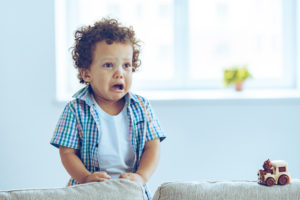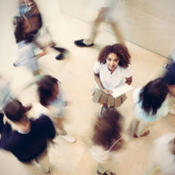 I remember my mother telling me that when I was a few months old she looked at me lying on her bed, probably crying and colicky, and came to the realization that I knew nothing. She would have to teach me everything. I was a blank slate with no understanding of language, emotion, or how to exist in the world. I depended on her to learn all of this and more (she did a great job, by the way). This sounded like an experience that left her feeling unsure, overwhelmed, and at a loss as to where to begin. I imagine most, if not all, parents can relate to this feeling of immense pressure to teach the new being before them how to live and function in so many different environments—and to do so in a way that leaves them feeling prepared and capable.
I remember my mother telling me that when I was a few months old she looked at me lying on her bed, probably crying and colicky, and came to the realization that I knew nothing. She would have to teach me everything. I was a blank slate with no understanding of language, emotion, or how to exist in the world. I depended on her to learn all of this and more (she did a great job, by the way). This sounded like an experience that left her feeling unsure, overwhelmed, and at a loss as to where to begin. I imagine most, if not all, parents can relate to this feeling of immense pressure to teach the new being before them how to live and function in so many different environments—and to do so in a way that leaves them feeling prepared and capable.
One important element of raising any child is healthy emotional and psychological development. We all know children, especially those 5 and under, are like adorable little sponges—willing and wanting to absorb all new information provided to them by the world. This can become overwhelming for a growing brain and nervous system, and toddlers can easily dissolve into tears, tantrums, anger, and more, unsure of how to manage the emotional range they’re experiencing. While this can also be overwhelming for parents and can result in similar tears, frustration, and meltdowns, helping your child navigate their emotions is easier than it may feel.
Children learn through observation and referencing; basically, monkey see monkey do. Thus, one of the simplest ways to begin helping your toddler learn emotional regulation and healthy coping is to show the child how you regulate in a healthy way. Screaming and throwing things begets screaming and throwing things. If you use negative or hurtful language toward yourself, your partner, friends, or child, you can expect to hear that language used by your toddler.
Responding to the child’s emotional needs appropriately and effectively will also help your child learn healthy emotional regulation. This is not to say you have to be or are expected to be a paragon of calm—in fact, showing your children that anger, sadness, frustration, and all other emotions are normal and healthy is essential. You do not have to hide “negative” feelings from your child; it’s important they see their parent(s) mirroring their own new and confusing emotions.
Explain your healthy emotional responses by simply telling your child what happened in an age-appropriate way, with age appropriate information, including why you responded the way you did. For example, watching an emotional animated film with your child may elicit some tears that may be concerning, confusing, or even downright scary for your child. Many children jump to the aid of their crying parents, attempting to comfort and console them—seeing mommy cry can be strange and upsetting. It’s okay to explain your reaction to your little one.
For me, the scene in Dumbo where Dumbo’s mom is rocking him through the bars of her cage after she is taken away for protecting him during the circus brings childlike tears every time. I might explain this to my child by saying, “Mommy is crying because Dumbo’s mommy can’t be with him right now, and if I couldn’t be with you I would be sad because I love you very much.” I would then hug my child close and give a big smile and say I was having a good time watching the movie together and that it’s okay to be sad and to cry. This is a healthy way of explaining the situation to a child: it shows sadness is okay, missing someone is okay, and that Mommy can have strong feelings but also calm down and return to happiness—and therefore they can, too.
In time, age-appropriate modeling and consistent and healthy responsiveness to children’s emotional needs helps them to become masters of their feelings and helps them grow into emotionally healthy children who are capable of navigating the day-to-day ups and downs of life.
Another technique for helping young children learn to identify their emotions is being what I call their “emotional sportscaster.” I encourage parents to speak for their child based on what they are witnessing in their toddler. Often our little ones don’t have the words to explain their emotions, so they let them out in other ways, like a tantrum. Usually children have “tells” that caregivers and parents can spot prior to the situation escalating to a full-blown meltdown. In these cases, I will tell parents to narrate what they are seeing and what they think is going on for their child in a way that acts to diffuse the catastrophic response (or at least put words and meaning to it).
For example, many children struggle to leave something they are enjoying. I frequently see this play out when transitioning to the end of a play therapy session. They often become frantic and try to play with everything else in the room in the last 5 minutes, refuse to clean up or leave, or melt into tears. I will narrate for that child how I see they are feeling by saying things like, “Oh, it looks like you are so upset right now that we have to leave the room. I know it’s very hard to stop playing and you’re having so much fun, but we will come back next time. Mommy, why don’t you give Johnny a big hug until he calms down? You can help him learn to make himself feel better.” I will then help them clean up by giving them a choice of what to clean up first; the sense of control over their decision can be helpful. Finally, I encourage the parent to shower the child with positive feedback and appreciation for how hard that was and what a good job the child did. I help support parents in taking over this narration whenever they see their child becoming emotional at home or out in public.
In time, age-appropriate modeling and consistent and healthy responsiveness to children’s emotional needs helps them to become masters of their feelings and helps them grow into emotionally healthy children who are capable of navigating the day-to-day ups and downs of life.
References:
- Kochanska, G. (2001). Emotional development in children with different attachment histories: The first three years. Child Development, 72(2), 474-490.
- Morris, A. S. (2001). The role of the family context in the development of children’s emotion regulation. Dissertation Abstracts International, 61, 5598B.
© Copyright 2017 GoodTherapy.org. All rights reserved. Permission to publish granted by Heather Zawislak, MA, LCSW, GoodTherapy.org Topic Expert
The preceding article was solely written by the author named above. Any views and opinions expressed are not necessarily shared by GoodTherapy.org. Questions or concerns about the preceding article can be directed to the author or posted as a comment below.

 Indiscriminate Affection and Children: The Real Stranger Danger
Indiscriminate Affection and Children: The Real Stranger Danger How to Help Teens Manage Their Emotions and Accept Their Feelings
How to Help Teens Manage Their Emotions and Accept Their Feelings Unhealthy Friendships in Adolescence: How to Know When to Let Go
Unhealthy Friendships in Adolescence: How to Know When to Let Go